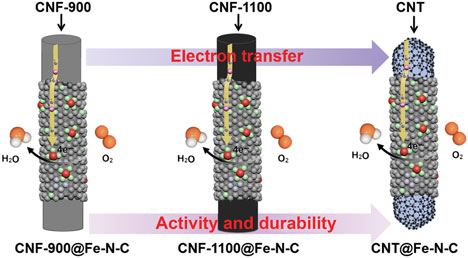Crossref Citations
This article has been cited by the following publications. This list is generated based on data provided by
Crossref.
Li, Jin-Cheng
Wei, Zidong
Liu, Dong
Du, Dan
Lin, Yuehe
and
Shao, Minhua
2019.
Dispersive Single-Atom Metals Anchored on Functionalized Nanocarbons for Electrochemical Reactions.
Topics in Current Chemistry,
Vol. 377,
Issue. 1,
Li, Xiaofeng
Zhang, Yuhao
Zhang, Jinfang
and
Wang, Congwei
2019.
Isolated Fe atoms dispersed on cellulose-derived nanocarbons as an efficient electrocatalyst for the oxygen reduction reaction.
Nanoscale,
Vol. 11,
Issue. 48,
p.
23110.
Karapinar, Dilan
Tran, Ngoc-Huan
Giaume, Domitille
Ranjbar, Nastaran
Jaouen, Frédéric
Mougel, Victor
and
Fontecave, Marc
2019.
FeNC catalysts for CO2 electroreduction to CO: effect of nanostructured carbon supports.
Sustainable Energy & Fuels,
Vol. 3,
Issue. 7,
p.
1833.
Li, Jin-Cheng
Xiao, Fei
Zhong, Hong
Li, Tao
Xu, Mingjie
Ma, Lu
Cheng, Min
Liu, Dong
Feng, Shuo
Shi, Qiurong
Cheng, Hui-Ming
Liu, Chang
Du, Dan
Beckman, Scott P.
Pan, Xiaoqing
Lin, Yuehe
and
Shao, Minhua
2019.
Secondary-Atom-Assisted Synthesis of Single Iron Atoms Anchored on N-Doped Carbon Nanowires for Oxygen Reduction Reaction.
ACS Catalysis,
Vol. 9,
Issue. 7,
p.
5929.
Li, Jin-Cheng
Cheng, Min
Li, Tao
Ma, Lu
Ruan, Xiaofan
Liu, Dong
Cheng, Hui-Ming
Liu, Chang
Du, Dan
Wei, Zidong
Lin, Yuehe
and
Shao, Minhua
2019.
Carbon nanotube-linked hollow carbon nanospheres doped with iron and nitrogen as single-atom catalysts for the oxygen reduction reaction in acidic solutions.
Journal of Materials Chemistry A,
Vol. 7,
Issue. 24,
p.
14478.
Wang, Jian
Kim, Juwon
Choi, Subin
Wang, Hongsheng
and
Lim, Jongwoo
2020.
A Review of Carbon‐Supported Nonprecious Metals as Energy‐Related Electrocatalysts.
Small Methods,
Vol. 4,
Issue. 10,
Sudarsono, W
Wong, W Y
Loh, K S
Majlan, E H
Syarif, N
Kok, K Y
Yunus, R M
and
Lim, K L
2020.
High performance iron-based oxygen reduction catalyst supported on sengon wood-derived reduced graphene oxide in acidic medium.
IOP Conference Series: Earth and Environmental Science,
Vol. 463,
Issue. 1,
p.
012060.
Hülstede, Julia
Schonvogel, Dana
Schmies, Henrike
Wagner, Peter
Schröter, Frank
Dyck, Alexander
and
Wark, Michael
2020.
Relevant Properties of Carbon Support Materials in Successful Fe-N-C Synthesis for the Oxygen Reduction Reaction: Study of Carbon Blacks and Biomass-Based Carbons.
Materials,
Vol. 14,
Issue. 1,
p.
45.
Sun, Zhen
Lin, Jinbao
Hou, Kun
Guan, Lunhui
and
Zhan, Hongbing
2020.
Pore engineering of an Fe–N–C electrocatalyst to enhance the performance for the oxygen reduction reaction by adding g-C3N4 into polyaniline and cyanamide as a precursor.
Journal of Materials Chemistry A,
Vol. 8,
Issue. 15,
p.
7273.
Jang, Dawoon
Lee, Yeunhee
Shin, Yunseok
Park, Sunghee
Jo, Changbum
Kim, Yong-Hyun
and
Park, Sungjin
2020.
Coordination structure of Jacobsen catalyst with N-modified graphene and their electrocatalytic properties for reducing oxygen molecules.
Applied Catalysis B: Environmental,
Vol. 263,
Issue. ,
p.
118337.
Sudarsono, Wulandhari
Wong, Wai Yin
Loh, Kee Shyuan
Majlan, Edy Herianto
Syarif, Nirwan
Kok, Kuan‐Ying
Yunus, Rozan Mohamad
and
Lim, Kean Long
2020.
Noble‐free oxygen reduction reaction catalyst supported on Sengon wood (
Paraserianthes falcataria L.
) derived reduced graphene oxide for fuel cell application
.
International Journal of Energy Research,
Vol. 44,
Issue. 3,
p.
1761.
Kostuch, Aldona
Jarczewski, Sebastian
Surówka, Marcin K.
Kuśtrowski, Piotr
Sojka, Zbigniew
and
Kruczała, Krzysztof
2021.
The joint effect of electrical conductivity and surface oxygen functionalities of carbon supports on the oxygen reduction reaction studied over bare supports and Mn–Co spinel/carbon catalysts in alkaline media.
Catalysis Science & Technology,
Vol. 11,
Issue. 23,
p.
7578.
Cheng, Yi
Zhang, Jinyang
Wu, Xing
Tang, Chongjian
Yang, Shi-ze
Su, Panpan
Thomsen, Lars
Zhao, Feiping
Lu, Shanfu
Liu, Jian
and
Jiang, San Ping
2021.
A template-free method to synthesis high density iron single atoms anchored on carbon nanotubes for high temperature polymer electrolyte membrane fuel cells.
Nano Energy,
Vol. 80,
Issue. ,
p.
105534.
Meng, Yu
Li, Jin-Cheng
Zhao, Shi-Yong
Shi, Chao
Li, Xiao-Qi
Zhang, Lili
Hou, Peng-Xiang
Liu, Chang
and
Cheng, Hui-Ming
2021.
Fluorination-assisted preparation of self-supporting single-atom Fe-N-doped single-wall carbon nanotube film as bifunctional oxygen electrode for rechargeable Zn-Air batteries.
Applied Catalysis B: Environmental,
Vol. 294,
Issue. ,
p.
120239.
da Silva Freitas, Williane
Mecheri, Barbara
Lo Vecchio, Carmelo
Gatto, Irene
Baglio, Vincenzo
Ficca, Valerio C.A.
Patra, Atanu
Placidi, Ernesto
and
D'Epifanio, Alessandra
2022.
Metal-organic-framework-derived electrocatalysts for alkaline polymer electrolyte fuel cells.
Journal of Power Sources,
Vol. 550,
Issue. ,
p.
232135.
Li, Wenxian
Guo, Zehao
Yang, Jack
Li, Ying
Sun, Xueliang
He, Haiyong
Li, Sean
and
Zhang, Jiujun
2022.
Advanced Strategies for Stabilizing Single-Atom Catalysts for Energy Storage and Conversion.
Electrochemical Energy Reviews,
Vol. 5,
Issue. 3,
Ding, Shichao
Lyu, Zhaoyuan
Sarnello, Erik
Xu, Mingjie
Fang, Lingzhe
Tian, Hangyu
Karcher, Sam Ellery
Li, Tao
Pan, Xiaoqing
McCloy, John
Ding, Guodong
Zhang, Qiang
Shi, Qiurong
Du, Dan
Li, Jin-Cheng
Zhang, Xiao
and
Lin, Yuehe
2022.
A MnOx enhanced atomically dispersed iron–nitrogen–carbon catalyst for the oxygen reduction reaction.
Journal of Materials Chemistry A,
Vol. 10,
Issue. 11,
p.
5981.
He, Tianwei
Puente‐Santiago, Alain R.
Xia, Shiyu
Ahsan, Md Ariful
Xu, Guobao
and
Luque, Rafael
2022.
Experimental and Theoretical Advances on Single Atom and Atomic Cluster‐Decorated Low‐Dimensional Platforms towards Superior Electrocatalysts.
Advanced Energy Materials,
Vol. 12,
Issue. 22,
Castelo-Quibén, J.
Bailón-García, E.
Moral-Rodríguez, A. I.
Carrasco-Marín, F.
and
Pérez-Cadenas, A. F.
2022.
Recycling and valorization of LDPE: direct transformation into highly ordered doped-carbon materials and their application as electro-catalysts for the oxygen reduction reaction.
Catalysis Science & Technology,
Vol. 12,
Issue. 4,
p.
1187.
Jiang, Weiya
Huang, Bing
Hu, Rongtao
Cui, Yaqi
and
Guan, Lunhui
2022.
Bead-like carbon fibers consisting of abundantly exposed active sites for the oxygen reduction reaction.
Nanotechnology,
Vol. 33,
Issue. 19,
p.
195401.




